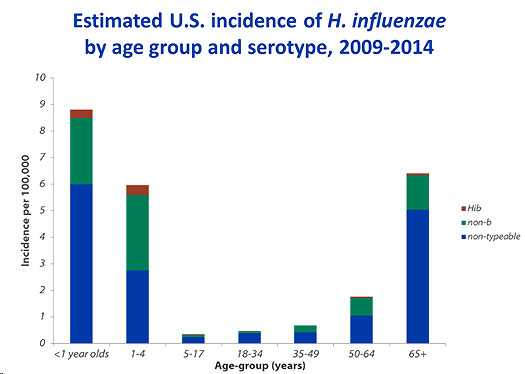Causes, How It Spreads, and People at Increased Risk
On this Page
Causes
Haemophilus influenzae disease is caused by the bacterium Haemophilus influenzae. There are six identifiable types of H. influenzae (a through f) and other non-identifiable types (called nontypeable). The one that people are most familiar with is H. influenzae type b, or Hib.
These bacteria live in the nose and throat, and usually cause no harm. However, the bacteria can sometimes move to other parts of the body and cause infection. Some of these infections are considered “invasive” and can be very serious and sometimes even deadly.
The incubation period (time between exposure and first symptoms) of H. influenzae disease is not certain, but could be as short as a few days.
How It Spreads
H. influenzae, including Hib, are spread person-to-person by direct contact or through respiratory droplets that are created when people cough or sneeze.
H. influenzae, including Hib, are spread person-to-person through respiratory droplets that occur when someone who has the bacteria in their nose or throat coughs or sneezes. Most of the time, H. influenzae are spread by people who have the bacteria in their noses and throats but who are not ill (asymptomatic).
Sometimes H. influenzae spread to other people who have had close or lengthy contact with a person sick with H. influenzae disease. In certain cases, people in close contact with that person should receive antibiotics (medicines that kill bacteria in the body) to prevent them from getting the disease. Learn more about antibiotic prophylaxis.
People at Increased Risk
H. influenzae, including Hib, disease occurs mostly in babies and children younger than five years old. Adults 65 years or older, American Indians, and Alaska Natives are also at increased risk for getting sick with invasive H. influenzae disease.
People with certain medical conditions are also at increased risk for developing H. influenzae disease. Those medical conditions include:
- Sickle cell disease
- Asplenia (no spleen)
- HIV (human immunodeficiency virus) infection
- Antibody and complement deficiency syndromes
- Receipt of chemotherapy or radiation therapy for malignant neoplasms
- Receipt of hematopoietic stem cell

- Page last reviewed: July 25, 2016
- Page last updated: July 25, 2016
- Content source:


 ShareCompartir
ShareCompartir